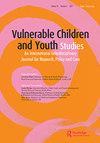The relationship between social media use and collective identity among the HIV/AIDS-affected adolescents: from the online social support perspective
IF 0.9
Q4 FAMILY STUDIES
引用次数: 1
Abstract
ABSTRACT Research has suggested social media use plays an important role in forming collective identity among marginalized groups. From the online social support perspective, this study aims to explore the relationship between social media use and collective identity of HIV/AIDS-affected adolescents. A field survey was conducted in Wen Lou village (a famous Chinese ‘AIDS Village’) and valid questionnaires were completed by the HIV/AIDS-affected adolescents. A linear regression analysis was conducted to detect how demographic variables, social media use and online social support predict the collective identity of the HIV/AIDS-affected adolescents. For social media use, △R2 = 0.157, p < .05; and for online social support, △R2 = 0.358, p < .001, specifically for instrumental support, β = .281, p < .05. Preference for social media use and online social support positively predict their collective identity, but social media use intensity negatively predicts their collective identity. There are no significant differences in the levels of social media use intensity, preference for social media use, online social support and collective identity between different genders of the HIV/AIDS-affected adolescents. The level of ‘ideology’ is quite low, many participants did not show negative emotions for being a member of the ‘AIDS Village’ adolescents, or show hatred to people outside the ‘AIDS Village’.受艾滋病毒/艾滋病影响的青少年使用社交媒体与集体认同之间的关系:从网络社会支持的角度
摘要研究表明,社交媒体的使用在边缘群体形成集体认同方面发挥着重要作用。从网络社会支持的角度,本研究旨在探讨受艾滋病毒/艾滋病影响的青少年的社交媒体使用与集体身份之间的关系。在中国著名的“艾滋病村”文楼村进行了实地调查,并对受艾滋病影响的青少年进行了有效问卷调查。进行了线性回归分析,以检测人口统计变量、社交媒体使用和在线社会支持如何预测受艾滋病毒/艾滋病影响的青少年的集体身份。对于社交媒体的使用,△R2 = 0.157,p < .05;以及对于在线社交支持,△R2 = 0.358,p < .001,专门用于仪器支持,β = .281,p < .05.对社交媒体使用的偏好和在线社交支持对他们的集体身份有正向预测作用,但社交媒体使用强度对他们的群体身份有负向预测作用。受艾滋病毒/艾滋病影响的不同性别青少年在社交媒体使用强度、社交媒体使用偏好、在线社会支持和集体认同水平方面没有显著差异。“意识形态”水平相当低,许多参与者没有表现出作为“艾滋病村”青少年成员的负面情绪,也没有表现出对“艾滋病村’以外的人的仇恨。
本文章由计算机程序翻译,如有差异,请以英文原文为准。
求助全文
约1分钟内获得全文
求助全文
来源期刊

Vulnerable Children and Youth Studies
FAMILY STUDIES-
CiteScore
1.90
自引率
0.00%
发文量
33
期刊介绍:
Vulnerable Children and Youth Studies is an essential peer-reviewed journal analyzing psychological, sociological, health, gender, cultural, economic, and educational aspects of children and adolescents in developed and developing countries. This international publication forum provides a much-needed interdisciplinary focus on vulnerable children and youth at risk, specifically in relation to health and welfare issues, such as mental health, illness (including HIV/AIDS), disability, abuse, neglect, institutionalization, poverty, orphanhood, exploitation, war, famine, and disaster.
 求助内容:
求助内容: 应助结果提醒方式:
应助结果提醒方式:


